A Visit To The Amish Of Pontotoc County, Mississippi (25 Photos)
Amish have lived in Pontotoc County, Mississippi for a quarter-century. I made an unplanned visit to this community in late January. It was slightly out of the way, but well worth it. I hope you enjoy these photos and my comments on this Swartzentruber Amish settlement of two church districts.
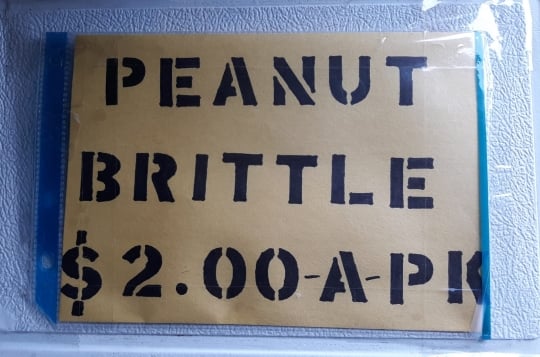
Amish came here in the mid-1990s, mainly from the settlement at Ethridge, Tennessee, and close ties remain. Once a week, a driver goes between the two communities, about a three-hour journey. The main town near this settlement is Randolph.

Randolph is just a speck on the map, with a post office and a small grocery store. If the Amish need access to a larger town, Pontotoc is about 8 to 10 miles away. As I was prepping this post I checked Google Maps’ street view just to orient myself, and what should I immediately see but this:

Google Maps image, June 2018
I wonder if the Amish driver there noticed the weird multi-directional camera on top of the Google car passing by that day. Anyway, back to the visit.
I happened to be in the vicinity following my trip to Ethridge, and remembered William Justice, who I’ve known via this site for probably ten years now. William had always told me about this community so I figured I’d shoot him an email.
Lucky for us, his schedule was flexible, and by afternoon the next day we were driving over to the Randolph settlement from Oxford.
Businesses
Knowing a bit of the background of this settlement I expected it to be similar in some ways to Ethridge, and I wasn’t disappointed. It’s something like a mini-Ethridge.
The Amish businesses in Pontotoc County resemble the ones at Ethridge, which would make sense.

They sell the same types of things, are located in the same small buildings and stands, and alert you to their presence with the same hand-lettered signs.

A harness shop.

Baskets in here.

Not sure what this place is.

Here’s a baked-goods-and-more place we visited.

Inside. Bread, a little blurry.

Made by an Amish girl in Nebraska. These Amish show a little marketing savvy, just like the people in Ethridge.

“Everything is Homemade.”

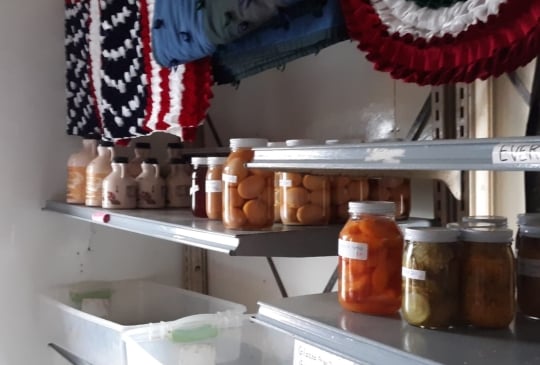

Coolers with candy. $3 a bag.

Talking to the Amish residents
We made stops at several Amish places that day. At one, a sawmill preparing pieces for hickory furniture was buzzing away. Countless hickory sticks stacked up by size surrounded the simple open setup.

We began speaking with the youngish man operating the saw, but I grew a bit concerned. He was speaking with us while rapidly running the the thin hickory logs through the saw, chopping each down to an appropriate length. I didn’t want to see his fingers come off there in front of us, and was relieved when he stepped away from the machine.
He was all smiles and I think enjoyed visiting with us, but I could tell he was eager to get back to his work. We let him back at it with a shared parting laugh. I would have liked to have spent longer there, as he seemed a pleasant and positive person.

At another we sat with an Amish woman in her small home and played the “Amish name game” about people we mutually knew in both Ethridge and in Ellenboro, NC, another settlement related to this one.
Finally we visited with an older Amishman in his workshop. His story was the most interesting of all. He and his family were key in the formation of two Amish settlements. His parents were the first family who settled in Ethridge, in the 1940s, arriving from a now-extinct community in a different part of Mississippi.

Then, in 1995, he was the one who came to Pontotoc County, buying a large tract of land which eventually became the heart of the settlement.
Pontotoc County buggies
If you’ve been reading this site since at least last year, you might be aware of the different adaptations that Swartzentruber Amish are now including on their buggies for safety.
Swartzentruber Amish refuse to use the orange SMV triangle. But that does not mean they are completely closed to the idea of visual safety enhancements on their vehicles.
The Amish in Ethridge are now affixing two short PVC pipes – which one Amishman jokingly called “beer cans” – onto the spokes of the back wheel, an idea that I believe was pioneered in the Lodi, Ohio community.

Ethridge PVC pipe buggy reflectors. Photo: FOX17
This creates a reflective fluttering or oscillating effect at night.

Ethridge buggy at night
At Ellenboro, North Carolina, the Amish use additional reflective material on the back of the buggy – what I’d describe as a large rectangular block with a chunk missing on the driver side, and an L-shape strip on the other side.
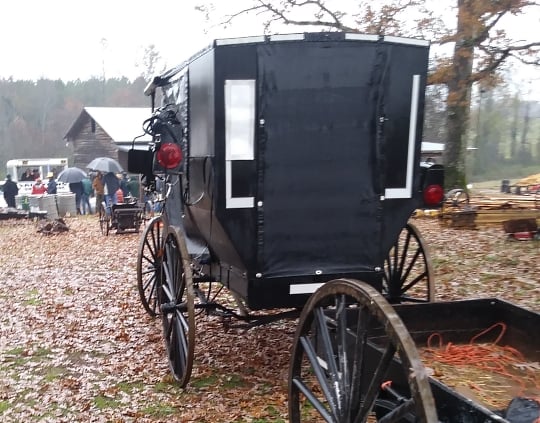
Ellenboro, NC buggy reflective material
The buggies in Pontotoc County sport something similar – though rather than a solid block patch on the left side, you have the symmetrical L-style strips on either side. And these are upside-down.

Pontotoc County, MS buggy
The solutions in the first two communities have been widely adopted within the past year or so. I didn’t ask, but I wouldn’t be surprised if the Pontotoc County elements appeared in a similar time frame.
Safety road
One last interesting thing to note on this community: this side road, which was either installed or allowed to be installed by the business here (I believe it’s a large non-Amish sawmill or lumber yard).
It appears to allow buggies to avoid having to use a section of the main road when traveling to a different part of the settlement.

Readers have wondered in the past why there aren’t separate roads for buggies in Amish communities. We do see wide dedicated buggy lanes on substantial stretches of road in places like Holmes County and Lagrange County, Indiana.

From time to time, you’ll also see these limited shortcut roads which allow Amish to go from one less-traveled country road to the next, without having to turn out into traffic. This one reminded me of another I spotted once in the Allen County, Indiana settlement.
I hope you enjoyed this visit to the Deep South’s only Amish community. How about one last photo from a different source, this one taken on a clearer day:




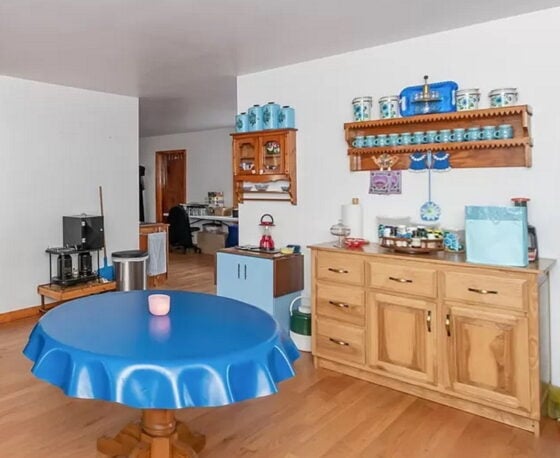
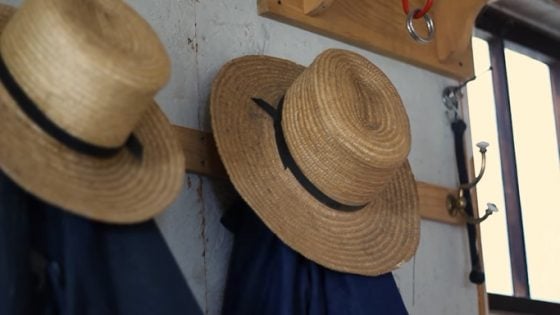

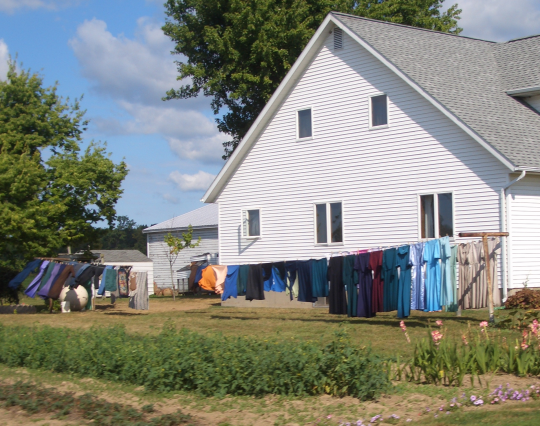
Pictures
Thanks for taking us to another Amish community! Living in the Pacific NW, we have no Amish in our state. I love seeing photos and hearing their stories! You see, My great grandparents and grandparents were Amish Menno. and moved West to start a church here… probably early 1900‘s. I remember Great Grandma, but my great grandpa died when I was very small, do not remember him or his horse & buggies!
I appreciate all of the photos and stories you provide here ~ THANKS
I’m happy you liked it, C.J. Yes, there have been very few Amish settlements on the West Coast in general. Just one in California long ago, and several in Oregon, also quite some time ago, though there was one more recently in Washington state. Neat that you have that background in your family, but sorry that there are not more Amish in your area. Maybe that will change. I don’t expect the Amish to stop growing – or moving to new places:)
MS Amish
I live about 50 miles from this settlement. My wife and I go there regularly and have made some close friendships. A couple of the families in particular have become like extended family to us. I enjoy estate/antique auctions and have been able through the years to pick up a lot of items they can use ( hand tools, corn shellers, treadle sewing machines, blacksmith tools, etc). My wife has bonded with several of the women by finding various pots and pans and dish patterns they are looking for. It’s always a treat for us to visit them. Thanks for including this community in your writings.
Nice to hear that you know this community well, Wesley. Well it was a long time coming, but I am happy that I was able to go there and do this post. I was only there for a few hours, but I found it to be a friendly community. And it was good to have a friend along who knows the area.
Looking for store name please
I believe by looking at pics of store that we visited a few years back. I was able to order friendship bread and they shipped it to me!
Do you have info? Please
Thank u!!
living in pontotoc ms....
i moved to the city of pontotoc five years ago and see a good many amish families that do business in our city. they are very nice people and i do purchase a good many of their crafts and furniture and homemade foods. i liked seeing your photos and reading your article. hope to see more of the pontotoc ms area.
Are the amish selling stuff
Was wondering if the amish were selling anything in November. Planning a trip November 7th 2020
Adirondack chairs
Does anyone know if the Amish community in Pontotoc still make Adirondack chairs?
Adirondack Chairs
They absolutely still make Adirondack chairs. My wife and I bought two of them this morning. Takes a month or more to get them since the fellow we dealt with only makes them when ordered. Great chairs and very reasonable.
Free
I live 5 1/2 hours away and was just thinking about stuff in regards to the Amish. I have two really good Jennings and was wondering if they would want them for free. If so, how would I be able to talk to them about it and get a plan together? Just wondering
Look for wood builders
I would like to find Amish made outdoor wood furniture. I also would like to have feeding birdhouses built to hand from trees.
mississippi Amish
Does anyone know if the Amish community is still there and selling products in Randolph, Mississippi
It’s still there and going strong! Over 200 Amish live there.
Thanksgiving
Hi. Does anyone know if the Randolph Amish community near Pontotoc, MS will be open for business during the Thanksgiving holiday weekend. Have family coming to visit and they would like to go. Thanks
Pontotoc Amish Leaving
I don’t know if they were open for Thanksgiving, but they are mostly all gone now. Many have already sold their homes. I’m not sure why they all left. I’ve lived in Pontotoc my entire life, and I love these families. Many homes have been sold, and the rest are for sale now. It’s very sad to see. I wish them luck wherever they’re going.
Hi! I live in the Algoma community not far from the Omish community and was wondering if anyone there in that community could possibly give us a quote on a barndominium home. We are looking into building one and would like some details on it!
Sincerely
Pamela Jones
Barndo build also
I’m looking into a barndo build as well, if you find anybody, I would appreciate a email. Thank you.
Hours of operation
What are the hours of business in the Randolph ms. Amish community
I would like to know if can shop in Randolph,Ms.. among the Amish during the week or they only sale on Saturdays cause really like their products and want to respect their ways
Amish stores are typically open during the week so it’s perfectly normal to visit then. Just not on Sundays. There also might be a day during the week that a given store will close so that the operator can take care of their own business. That can vary by the store, so just be aware. But generally they are all open weekdays.
Would like to learn more about visiting the Amish.
Where can you go in MS.to see and buy Amish products?
If you want to buy direct from the Amish, this community is the only one in the state. I always recommend just taking a drive, you will see simple white painted signs outside homes with goods for sale. You can also ask at your first stop for other places they recommend.
Where oh where
Looked for the Amish in pontotoc ms. Could not find salmon rd. Got an address. Two hours and over a 100 miles later…nothing.
Looking for a place to stay a couple of night in Randolph Mississippi
It’s our Anniversary and I always wanted to visit the Amish community and I would love to go there